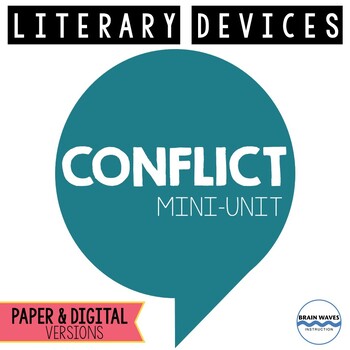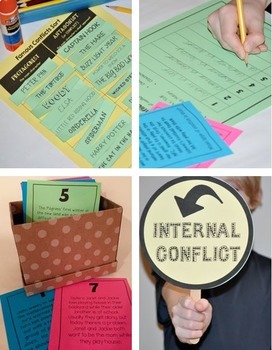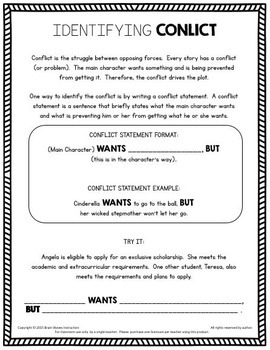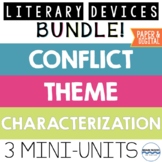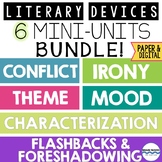Conflict Mini-Unit: Understanding Types of Conflict w/ Google Classroom Version
- PDF
- Google Apps™

What educators are saying
Also included in
- This bundle includes three 3-day mini-units on Theme, Conflict, and Characterization.Great News! The student packets in each mini-unit are also available as a Google Slides resource. In addition to the PDF version, students can complete the packet pages via a file sharing service such as Google DrivPrice $14.99Original Price $16.47Save $1.48
- Save BIG with this bundle of LITERARY DEVICES mini-units --- Theme, Conflict, Characterization, Irony, Mood, Flashbacks and Foreshadowing!This bundle includes SIX 3-day mini-units!Great News! The student packet in each mini-unit is also available as a Google Slides resource for students. In additionPrice $27.99Original Price $32.94Save $4.95
Description
Understanding the central conflict in literature is essential to grasping a work’s overriding themes. Help students identify the core types of conflicts in literary pieces with this mini-unit. When students can identify a story’s conflict, they can accurately summarize and analyze a text. This engaging and powerful 3-Day Mini-Unit is designed to help students do just that!
This conflict mini-unit provides numerous opportunities to develop the skill of identifying conflict. Each lesson starts with a fun and engaging activity – Famous Conflict Sort, Internal and External Conflict Judging (with paddles), and Conflict Task Cards. Then, students learn about and practice identifying conflict through whole group instruction, small group work, partnerships, and independent practice.
In this mini-unit, students will develop a deep understanding of literary devices, conflict, internal and external conflict, as well as the four major types of conflict in literature (character vs. self, character vs. character, character vs. nature, and character vs. society). Students will complete guided notes, reading comprehension passages, graphic organizers and conflict sketches. In addition, they’ll practice identifying conflict with conflict statements and while reading short and long reading passages (5). This is a fun unit for students and teachers!
Great News! The student packet is also available as a Google Slides resource for students. In addition to the PDF version, students can complete the packet pages via a file sharing service such as Google Drive, Google Classroom, or in the internet “cloud.” The digital version of the packet is accessible from any computer and allows students to complete their work online.
* FYI: The anticipatory set activities that accompany each lesson are NOT in a digital format. They will still need to be printed for students due to the hands-on and interactive nature of the activities.
This detailed CONFLICT mini-unit includes:
• 3 Detailed Daily Lesson Plans
• Famous Conflict Sort Activity with Protagonists and Antagonists
• Internal and External Conflict Paddle Cards
• Passages for Conflict Judging (8)
• Conflict Task Cards (8) and Record Sheet
• Guided Notes on Literary Devices, Conflict, and Types of Conflict
• 3 Short Practice Passages with Short Answer Questions
• Types of Conflict Graphic Organizer
• Types of Conflict Practice
• Conflict Definitions and Sketch Graphic Organizer
• Identifying Conflict Guided Notes
• Conflict Statement Practice
• 2 Long Practice Passages with Multiple Choice and Short Answer Questions
• All keys for student work and instruction
FYI: This unit is also a part of a Literary Devices Bundle. The bundle is filled with 6 fun mini-units to teach literary devices! You can check it out HERE.
You may also like…
• Reading Comprehension Skills – Mini-Units - Context Clues, Inferences, Cause and Effect, Main Idea, Sequencing, and Predicting
• 20 Creative Reading Response Activities
• Myth Study and Writing Unit - Includes both an integrated and stand-alone version of the unit
Following is Fun!
Get the inside scoop on all store discounts, free products, and product launches. Just click the green “Follow Me” star under my store name on this page or click the green “Follow Me” star on my store homepage.
Let’s Stay in Touch!
*** Click HERE to receive the Brain Waves Instruction Newsletter filled with exclusive FREEBIES and Teaching Tips!
Thanks!
Brain Waves Instruction

